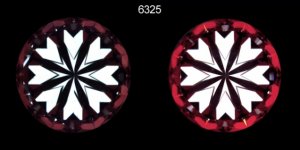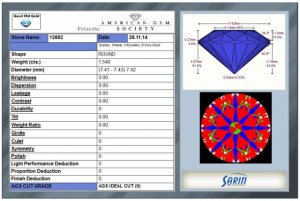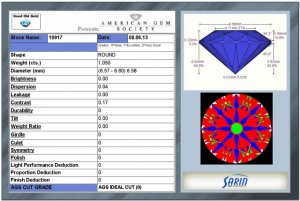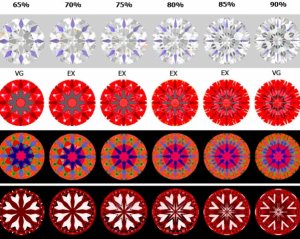- Joined
- Oct 21, 2004
- Messages
- 5,096
Re: Quantifying Performance Nuances beyond ASET, H&A Photos,
We try to tell the ongoing story where the laboratories stop for various reasons which non are innovation - advancement.
The beauty of this place is simply for the fact that we share this information.
You can do with it as you like.
The fact that products already exist that AGSL does not recognize as above their top range is just a fact, we will need to overcome such obstacles. Give us some time as we justify our advancement claims. It's not such an easy task but well worth it I believe. After all Diamond material is the most valuable substance on earth. It certainly deserves such high detailing crafted by human hands. Some definitely appreciate the efforts, I thank and salute those who do.
I disagree with everyone who claims optical precision is not quantifiable at this stage and time, it's true, we can't put numbers on them yet but we can definitely visualize any differences in ETAS. (Virtual ETAS is problematic as it depends on 3D scans which include limitation errors!). But real ETAS is the most sensitive tool available. We have been researching real ETAS for over a year now. It's complicated but even slight out of 3D symmetry will be noticed and recognized. Real ETAS conclusions can give us a good direction of LP potential. (You can see an old visual of a real ETAS in my avatar.)
This thread is focused towards round brilliants but if you take fancy shapes into account optical precision becomes more complicated and interesting.
We are still in the diaper stages of optical design as far as Diamonds are concern.
I do wish AGSL would be a bit more welcoming to optical designs outside of their ray tracing "box" which was originally designed for round brilliants.
You are right of course, PS is the place if someone is looking for high[est] level education. For pros as for consumers.KobiD|1428140301|3856793 said:diamondseeker2006|1428127981|3856754 said:pfunk said... If I can buy an ideal stone of 7.9mm diameter for the same price as a 7.5mm superideal, which do I buy? Is the effect of size more noticeable than symmetry?
The thing you are not taking into account is that size is not everyone's number one priority. I just bought superideal cut diamonds for earrings (upgrade policy) and I certainly could have gotten bigger stones had I gone with virtual inventory GIA EX. Same with my e-ring diamond which is a specialty cut. I could easily have gotten a GIA EX 3 ct mrb instead by dropping a little in clarity, too, but I didn't want a 3 ct diamond. Sometimes people choose quality over quantity. Bigger is not better to everyone. I remember a guy coming here one time with a $20k budget and he wanted a 1 ct D VVS-IF diamond. That is certainly not for everyone, but it is what his girlfriend wanted. Different people have different preferences.
Good points DS, which also compliment exactly what pfunk is trying to address.
Everyone who comes here seeking advice does so with their own set of priorities, or a general idea of what they seek to achieve. The forum provides the insight and shares the knowledge required to assist them in achieving their goals. Educating consumers about diamonds is something that the people here do, and do to a very high level.
However, all too often you see someone come with a limited understanding, not sure what they really want.. and from what I have seen they are almost always pushed towards super ideals. That by buying any less they are ultimately giving up something... something that can be qualified (selectively using ASET/IS), but not quantitivly at this stage in time. They are then faced with an option to either extend their budget, drop colours/clarity, or buy a smaller diamond.
I haven't been here long, but I have seen it unfold time and time again. On the other hand, if someone does come with a set of priorities or a particular goal I have also witnessed many of the regulars work towards that, even if it doesn't align with their own opinions/tastes.
I personally would be happy with some of WFs expert selection. I appreciate the symmetry, but don't need the perfect ASET/IS. Some leakage adds some character, as do inclusions to some people, as others like warmer coloured stones. Its all about what works for you... but for someone who doesn't particularly fuss over their stone, who isn't interested in gazing deeply at it at all hours, who doesn't desire to own a loupe, ah&a viewer, a mircroscope.. are they actually going to be aware of the small (unmeasurable) amount of performance they are giving up.
We try to tell the ongoing story where the laboratories stop for various reasons which non are innovation - advancement.
The beauty of this place is simply for the fact that we share this information.
You can do with it as you like.
The fact that products already exist that AGSL does not recognize as above their top range is just a fact, we will need to overcome such obstacles. Give us some time as we justify our advancement claims. It's not such an easy task but well worth it I believe. After all Diamond material is the most valuable substance on earth. It certainly deserves such high detailing crafted by human hands. Some definitely appreciate the efforts, I thank and salute those who do.
I disagree with everyone who claims optical precision is not quantifiable at this stage and time, it's true, we can't put numbers on them yet but we can definitely visualize any differences in ETAS. (Virtual ETAS is problematic as it depends on 3D scans which include limitation errors!). But real ETAS is the most sensitive tool available. We have been researching real ETAS for over a year now. It's complicated but even slight out of 3D symmetry will be noticed and recognized. Real ETAS conclusions can give us a good direction of LP potential. (You can see an old visual of a real ETAS in my avatar.)
This thread is focused towards round brilliants but if you take fancy shapes into account optical precision becomes more complicated and interesting.
We are still in the diaper stages of optical design as far as Diamonds are concern.
I do wish AGSL would be a bit more welcoming to optical designs outside of their ray tracing "box" which was originally designed for round brilliants.







300x240.png)